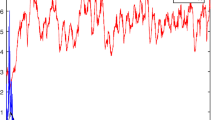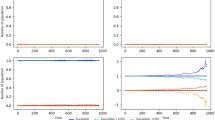Abstract
In this paper we extend the classical SIS epidemic model from a deterministic framework to a stochastic one. We also study the long time behavior of the stochastic system. We mainly establish conditions for the extinction of disease from the population as well as the persistence of disease under different conditions. In the case of persistence, we show the existence of a stationary distribution. we found that the introduction of stochastic noise changes the basic reproduction number. The presented results are demonstrated by numerical simulations.





Similar content being viewed by others
References
Allen LJ (2010) An introduction to stochastic processes with applications to biology. CRC Press, Boca Raton
Andersson H, Britton T (2012) Stochastic epidemic models and their statistical analysis, vol 151. Springer, Berlin
Beretta E, Kolmanovskii V, Shaikhet L (1998) Stability of epidemic model with time delays influenced by stochastic perturbations. Math Comput Simul 45(3):269–277
Casagrandi R, Bolzoni L, Levin S, Andreasen V (2006) The sirc model and influenza a. Math Biosci 200:152–169
Da Prato G, Zabczyk J (1996) Ergodicity for infinite dimensional systems, vol 229. Cambridge University Press, Cambridge
Dalal N, Greenhalgh D, Mao X (2007) A stochastic model of aids and condom use. J Math Anal Appl 325:36–53
Dang NH, Du NH, Ton TV (2011) Asymptotic behavior of predator-prey systems perturbed by white noise. Acta Appl Math 115(3):351–370
Durrett R (1996) Stochastic calculus: a practical introduction, vol 6. CRC Press, Boca Raton
Gray A, Greenhalgh D, Hu L, Mao X, Pan J (2011) A stochastic differential equation sis epidemic model. SIAM J Appl Math 71(3):876–902
Gray A, Greenhalgh D, Mao X, Pan J (2012) The sis epidemic model with markovian switching. J Math Anal Appl 394(2):496–516
Greenhalgh D, Liang Y, Mao X (2015) Demographic stochastic in the sde sis epidemic model. Discret Cont Dyn-B 20:2859–2884
Herbert H, Yorke J (1984) Gonorrhea transmission dynamics and control, vol 56. Lecture Notes in Biomathematics. springer-verlag edn, Berlin
Hethcote H (2000) The mathematics of infectious diseases. SIAM Rev 42:599–653
Imhof L, Walcher S (2005) Exclusion and persistence in deterministic and stochastic chemostat models. J Differ Equ 217(1):26–53
Kloeden PE, Platen E (1992) Higher-order implicit strong numerical schemes for stochastic differential equations. J Stat Phys 66(1–2):283–314
Korobeinikov A, Wake G (2002) Lyapunov functions and global stability for sir, sirs, and sis epidemiological models. Appl Math Lett 15:955–960
Lahrouz A, Omari L (2013) Extinction and stationary distribution of a stochastic sirs epidemic model with non-linear incidence. Stat Probab Lett 83(4):960–968
Lahrouz A, Settati A (2013) Asymptotic properties of switching diffusion epidemic model with varying population size. Appl Math Comput 219(24):11134–11148
Lahrouz A, Settati A (2014a) Necessary and sufficient condition for extinction and persistence of sirs system with random perturbation. Appl Math Comput 233:10–19
Lahrouz A, Settati A (2014b) Qualitative study of a nonlinear stochastic sirs epidemic system. Stoch Anal Appl 32(6):992–1008
Lahrouz A, Omari L, Kiouach D, Belmaati A (2012) Complete global stability for an sirs epidemic model with generalized non-linear incidence and vaccination. Appl Math Comput 218:6519–6525
Lin Y, Jiang D, Wang S (2014a) Stationary distribution of a stochastic sis epidemic model with vaccination. Phys A Stat Mech Appl 394:187–197
Lin Y, Jiang D, Xia P (2014b) Long-time behavior of a stochastic sir model. Appl Math Comput 236:1–9
Liu M, Wang K, Wu Q (2011) Survival analysis of stochastic competitive models in a polluted environment and stochastic competitive exclusion principle. Bull Math Biol 73(9):1969–2012
Mandal PS, Banerjee M (2012) Stochastic persistence and stationary distribution in a holling-tanner type prey-predator model. Phys A Stat Mech Appl 391(4):1216–1233
McCluskey A, van den Driessche E (2004) Global analysis of two tuberculosis models. J Dyn Differ Equ 16(2):139–166
Nåsell I (1996) The quasi-stationary distribution of the closed endemic sis model. Adv Appl Probab 28:895–932
Nåsell I (2011) Extinction and quasi-stationarity in the stochastic logistic SIS model, vol 2022. Springer, Berlin
Norris J (1986) Simplified malliavin calculus. Séminaire de Probabilités XX 1984/85. Springer, Berlin, pp 101–130
Rudnicki R (2003) Long-time behaviour of a stochastic prey-predator model. Stoch Processes Appl 108(1):93–107
Rudnicki R, Pichór K (2007) Influence of stochastic perturbation on prey-predator systems. Math Biosci 206(1):108–119
WHO (2004) The global burden of disease: 2004 update. www.who.int/healthinfo/global_burden_disease/GBD_report_2004update_full.pdf
Xia P, Zheng X, Jiang D (2013) Persistence and nonpersistence of a nonautonomous stochastic mutualism system. Abstr Appl Anal 2013:13
Yang Q, Jiang D, Shi N, Ji C (2012) The ergodicity and extinction of stochastically perturbed sir and seir epidemic models with saturated incidence. J Math Anal Appl 388(1):248–271
Zhou J, Hethcote H (1994) Population size dependent incidence in models for diseases without immunity. J Math Biol 32:809–834
Zhu C, Yin G (2007) Asymptotic properties of hybrid diffusion systems. SIAM J Control Optim 46(4):1155–1179
Acknowledgments
The authors are grateful to the editor and the anonymous reviewers for their careful reading and valuable suggestions which improved the quality of the paper.
Author information
Authors and Affiliations
Corresponding author
Rights and permissions
About this article
Cite this article
Lahrouz, A., Settati, A. & Akharif, A. Effects of stochastic perturbation on the SIS epidemic system. J. Math. Biol. 74, 469–498 (2017). https://doi.org/10.1007/s00285-016-1033-1
Received:
Revised:
Published:
Issue Date:
DOI: https://doi.org/10.1007/s00285-016-1033-1




